Hello there! Today, we’re going to explore some of the most popular feeder insects we use to satisfy the appetites of our animals. For those who are new here, currently our collection mainly consists of tarantulas, praying mantises, and jumping spiders. Countless other viable feeder options are available for your pets out there. This list primarily covers the most common ones that we use. If you’re new to the hobby, consider it a starting point.
Let's begin with everyone's favorite... roaches!
When I first got into the hobby, the idea of keeping roaches at my home was a bit terrifying. But hey, in several years, we’ve had zero escapes or any issues. Just remember to keep them clean and ensure they cannot escape. None of the species mentioned below can climb slippery surfaces, so they are not really escape artists.
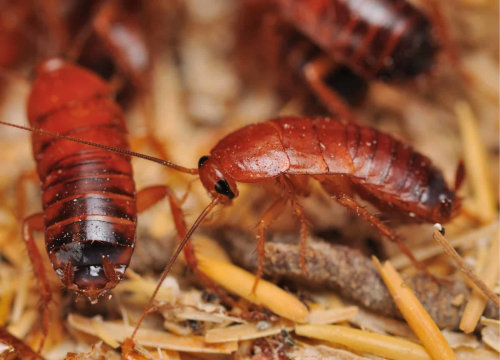
Shelfordella lateralis
Red runner / Turkestan cockroach
If I had to pick one, the most universal feeder, these critters would be it. They serve as the nutritional foundation of our microwilderness and are easy to maintain, although cleaning can be somewhat cumbersome. Once a red roach colony is established, they quickly begin breeding to ensure nobody goes hungry.
Temperature: 27-32C
Humidity: 30-40%
Maintenance: intermediate
Viable for: all sizes of praying mantises, tarantulas, jumping spiders
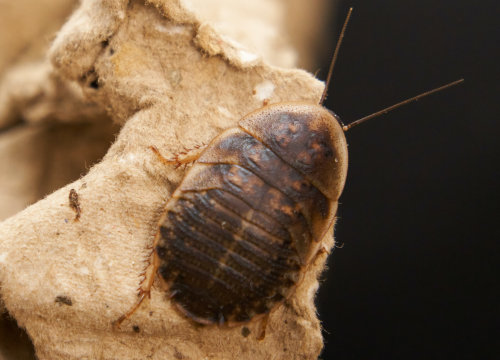
Blaptica dubia
Dubia roach / Argentinian wood roach
Roaches that resemble prehistoric trilobites often do not elicit the same negative response in humans as many other types of roaches do. They are not very fast-moving and are somewhat easier to keep than Shelfordella lateralis. Dubia roaches are highly nutritious but have hard exoskeletons with lots of chitin, making them less suitable for smaller praying mantis species.
Temperature: 27-32C
Humidity: 30-60%
Maintenance: easy
Viable for: praying mantises (medium/large species), tarantulas, jumping spiders (adults can eat nymphs)
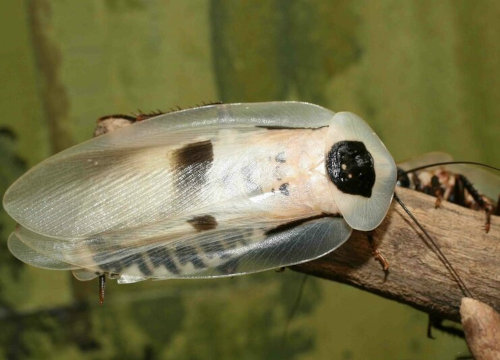
Blaberus giganteus
Giant cave cockroach / Brazilian cockroach
Some people keep them as pets due to their impressive size. Care for them is similar to caring for Dubia roaches. Blaberus giganteus grows larger than Dubia roaches and is suitable primarily for juvenile and adult tarantulas, as well as the largest species of praying mantises.
Temperature: 24-29C
Humidity: 30-60%
Maintenance: easy
Viable for: tarantulas
Locusts - the protein-packed solution for your insectivorous pets
Locusts have had their reputation damaged by historical accounts in the Old Book and unfortunate interactions with humans in Africa. However, their standing within the reptile and arachnid hobby is much more favorable, as they make excellent feeder insects. You can readily acquire them at any reptile expo, where they are often available in various sizes. They thrive in a warm and arid environment, enjoying a diet of leafy green vegetables before becoming a meal themselves. Species mentioned below are so similar, for the purposes of our list we’re going to count them as one.
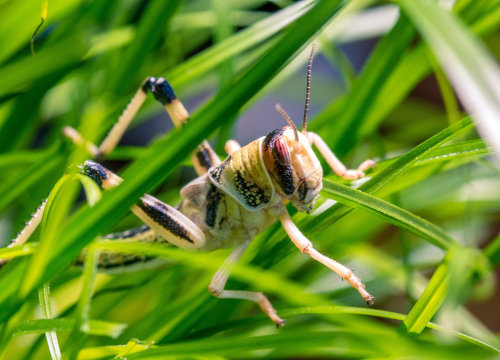
Schistocerca gregaria
The desert locust
The desert locust is considered one of the most formidable locust pests due to the swarms’ capacity to fly rapidly across vast distances. However, in the realm of exotic animal keeping, they are exceptional feeder insects. Their agile jumping abilities make them an engaging and stimulating prey option for your animals, encouraging natural hunting behaviors.
Temperature: 30-35C
Humidity: 20-40%
Maintenance: easy
Viable for: all sizes of praying mantises, tarantulas, jumping spiders

Locusta migratoria
The migratory locust
Both desert and migratory locusts are excellent and nutritious choices as feeder insects for various exotic pets. Adult specimens of migratory locusts tend to be slightly smaller than desert locusts, making them better suited for arachnids and praying mantises. The care requirements for both species are similar.
Temperature: 30-35C
Humidity: 20-40%
Maintenance: easy
Viable for: all sizes of praying mantises, tarantulas, jumping spiders
Feeder worms: nourishment and enrichment for your pets
Keeping worms is as straightforward as it gets, making them a convenient and beneficial addition to your exotic pets’ nutrition. However, it’s essential to remember that worms are relatively high in fat content and should not be the primary foundation of your pets’ diets. Instead, consider them as an occasional treat in addition to more nutritious meals, such as cockroaches or locusts.

Tenebrio molitor
Mealworm
Mealworms find application as pet food for captive reptiles, fish, birds, and select small mammals. Additionally, they serve as a supplemental food source for wild birds, especially during their nesting season. These versatile insects are even utilized as bait for fishing. Keep them cold to prevent them turning into beetles.
Temperature: 10-15C
Humidity: 10-20%
Maintenance: easy
Viable for: praying mantises (all sizes), tarantulas (slings), jumping spiders
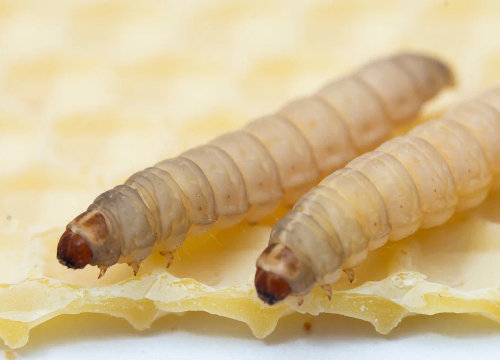
Galleria mellonella
Waxworm
Waxworms are versatile feeder insects that can be used in both their larval worm form and as adult moths. They require minimal care, with maintenance as simple as placing a small container in the refrigerator. In their natural habitat, waxworms exist as nest parasites within bee colonies, where they consume bee cocoons, pollen, shed bee skins, and even chew through beeswax—hence their name.
Temperature: 10-15C
Humidity: 10-20%
Maintenance: easy
Viable for: praying mantises (all sizes), tarantulas (slings), jumping spiders
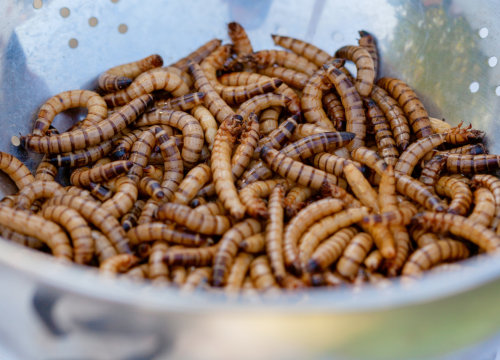
Zophobas morio
Superworm
Superworms stand out as one of the most widely employed feeder options for tarantulas. They are incredibly easy to care for, grow to a substantial size, and effectively trigger feeding responses in tarantulas. However, it’s worth noting that they are too large to be used as prey for jumping spiders. They remain a viable choice for larger species of praying mantises.
Temperature: 27-32C
Humidity: 10-20%
Maintenance: easy
Viable for: praying mantises (large species), tarantulas
A few more honorable mentions
Remember the importance of observing your pet’s behavior and habits and continuously expanding your knowledge. Don’t hesitate to seek advice from experienced keepers if you have any questions, and always strive to provide the best possible care.
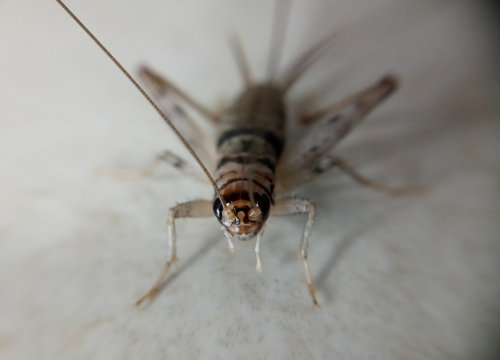
Acheta domesticus
House cricket
Always acquire crickets exclusively from reputable and trustworthy breeders, and maintain cleanliness of their enclosure to prevent potential issues. While crickets can serve as an occasional treat, I wouldn’t recommend them as a daily meal for your pets. Those guys can be pain in terms of maintenance.
Temperature: 25-30C
Humidity: 30-60%
Maintenance: intermediate/advanced
Viable for: praying mantises (all sizes), tarantulas (slings, juveniles), jumping spiders
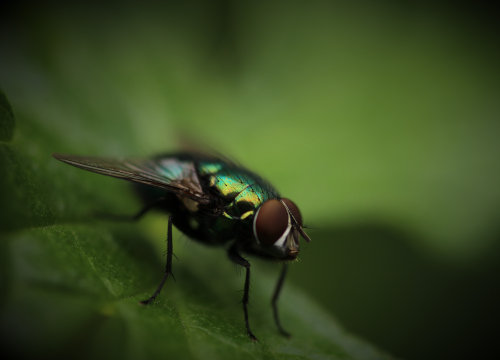
Lucilia sericata
Common green bottle fly
Another excellent feeder insect for jumping spiders and praying mantises are flies. Flies are straightforward to maintain; you can simply place a container with their larvae in the refrigerator. As the flies hatch, you can use tweezers to capture them and feed them to your pets. Alongside Sherfordella lateralis roaches, flies should form a foundational part of a healthy praying mantis diet.
Temperature: 10-15C
Humidity: 70-80%
Maintenance: easy
Viable for: praying mantises (all sizes), tarantulas (slings), jumping spiders

Drosophila melanogaster
Fruit flies
Fruit flies are commonly used by keepers worldwide to feed the youngest nymphs of praying mantises and arachnid slings. They are typically provided in a plastic cup with ventilation at the top. Fruit flies are easy to care for and do not require any special maintenance. One potential drawback can be the odor of their substrate, although this depends on the ingredients used. For instance, the fruit flies we purchase do not produce a noticeable smell.
Temperature: 21-27C
Humidity: 60-70%
Maintenance: easy
Viable for: praying mantises (nymphs), jumping spiders (nymphs), tarantulas (dwarf species)
Final thoughts!
Similar to humans, your exotic pets thrive on a diverse, high-quality diet. There isn’t a single “best” feeder item; the key lies in diversifying their menu and ensuring its quality. Your pets’ health is intricately connected to the quality of the prey items you provide them with.

